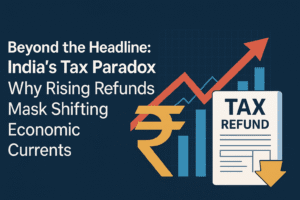Beyond the Headline: India’s Tax Paradox – Why Rising Refunds Mask Shifting Economic Currents
India’s direct tax collections dipped 1.87% year-on-year (April–August 11 period), primarily driven by a sharp 21% surge in corporate tax refunds—totaling ₹1.03 lakh crore—which injected significant liquidity back into businesses. While gross corporate tax revenue still grew 8%, net collections rose only 3% after these refunds.
Conversely, collections from individuals, HUFs, and smaller firms weakened, with gross revenue falling 8% and net down 7.5%. Overall net tax revenue fell 3.95%, reflecting both deliberate corporate refund outflows and underlying softness in the non-corporate taxpayer segment. Experts note early-year volatility but stress monitoring individual tax recovery and corporate payment trends in upcoming cycles to gauge broader economic momentum.

Beyond the Headline: India’s Tax Paradox – Why Rising Refunds Mask Shifting Economic Currents
Recent government data revealing a 1.87% dip in India’s gross direct tax collections (April 1 – August 11, FY26 vs FY25) might initially spark concern. However, digging deeper reveals a nuanced fiscal story driven by significant shifts in refund patterns and taxpayer segments, painting a more complex picture than the headline contraction suggests.
The Core Numbers: A Tale of Two Trends
- The Refund Surge: The standout figure is the dramatic 10% jump in overall tax refunds, reaching ₹1,34,948 crore. This isn’t spread evenly:
- Corporate Refunds Explode: Refunds to companies soared by a massive 21.24% to ₹1,03,863 crore. This is the primary engine driving the gross collection decline.
- Individual Refunds Decline: In contrast, refunds to non-corporate taxpayers (mainly individuals) actually fell by 16.5% to ₹31,081 crore.
- The Collection Conundrum:
- Corporate Tax Resilience: Despite hefty refunds, gross corporate tax collections actually grew healthily by 8.02% (₹3,32,822 crore). Even net collections (after refunds) showed a 3% increase (₹2,28,959 crore), indicating underlying corporate profitability remains robust.
- Individual Tax Softness: This is where the weakness lies. Gross collections from non-corporate taxpayers fell 8.14% (₹4,43,355 crore). Net collections also dropped 7.45% (₹4,12,274 crore), suggesting lower advance tax payments or TDS deductions for individuals, HUFs, and firms.
The Net Effect: A 3.95% Dip
The combined impact of much higher corporate refunds and lower individual collections resulted in a 3.95% decline in net direct tax revenue (₹6,63,874 crore vs ₹6,91,153 crore last year).
Decoding the Signals: More Than Just a Dip
- Corporate Cash Flow Boost: The surge in corporate refunds is significant. It suggests:
- Companies may have overpaid advance taxes in the previous year based on higher profit projections.
- Potentially higher claims for deductions, losses carried forward, or dispute resolutions favouring businesses.
- Impact: This injects substantial liquidity back into the corporate sector, potentially aiding investment or debt reduction.
- The Individual Puzzle: The dip in individual/HUF/firm collections warrants attention. Possible contributors include:
- Slower Income Growth: Especially in salaried classes or specific sectors.
- Investment Shifts: Increased utilization of deductions under sections like 80C or 80D, reducing net taxable income.
- Economic Caution: Individuals might be withholding larger advance tax payments due to economic uncertainty, preferring to pay closer to deadlines.
- A Dynamic System, Not a One-Way Street: As Hitesh Sawhney (Partner, PwC) points out, tax collections are inherently dynamic. “Tax collections cannot just have a one-way trajectory… what we are observing is basically just the impact of refund outflows on the government’s net revenue position in the early part of the fiscal year.” Early-year figures, heavily influenced by advance tax and refund processing, can be volatile.
Looking Ahead: Implications and Questions
- Short-Term Fiscal Pressure: Higher refunds and lower individual collections create near-term pressure on government coffers, potentially impacting spending plans if the trend persists.
- Corporate Health vs. Broader Base: While corporate gross collections grew, the significant refund outflow and the dip in the non-corporate segment (which forms a large part of the base) highlight a vulnerability. A sustainable tax base needs strength across both segments.
- Monitoring Key: The next advance tax installment (September 15th) will be crucial. Will corporate payments remain strong? Will individual payments show recovery? This data will offer a clearer signal of underlying economic momentum.
The Takeaway: Beyond the Contraction
The 1.87% gross contraction and 3.95% net dip in direct taxes are not merely indicators of an economic slowdown. They reflect a complex interplay: a deliberate, significant liquidity boost to the corporate sector via refunds, coupled with a concerning softness in collections from the vast non-corporate taxpayer base. While early-year volatility plays a role, this data underscores the importance of monitoring both refund patterns and the health of the individual taxpayer segment for a complete understanding of India’s fiscal trajectory and underlying economic currents. The story isn’t just about less tax collected; it’s about where the money is flowing back and which segments are contributing less, revealing shifting dynamics beneath the surface.
You must be logged in to post a comment.